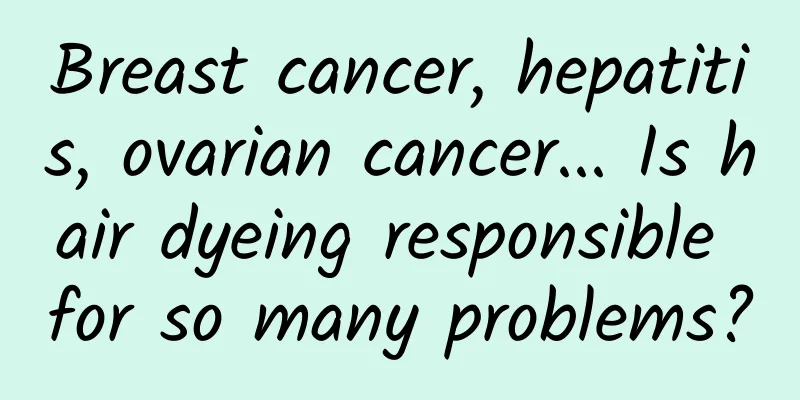Breast cancer, hepatitis, ovarian cancer... Is hair dyeing responsible for so many problems?

|
People often say that dyeing your hair frequently is bad for your liver, and similar news often appears. Related reports, image source: Weibo Will you get drug-induced hepatitis if you dye your hair twice a month? Does hair dyeing really harm the body? So for ordinary people, what is the safe frequency of hair dyeing? What is drug-induced hepatitis? Drug-induced hepatitis means that drugs damage the liver, so it is also called drug-induced liver injury (DILI). However, the medicines mentioned here include not only the tablets and capsules we are familiar with, but also traditional Chinese medicine, health products, dietary supplements, etc. Drugs that may be associated with liver damage, image source: Drug-induced liver damage professional website Drug-induced hepatitis can be divided into two categories based on the cause. One is a problem with the drug itself. A dietary supplement called "Lipokinetix" was once sold in the United States, claiming to help people lose weight quickly. However, many people developed liver disease after taking it, and some had to undergo liver transplants. The second category is a bit special. There is nothing wrong with the drug itself, but misuse will cause trouble. For example, paracetamol (acetaminophen) is a very common drug used primarily to treat fever. If fever is compared to a fire, paracetamol is water, and the enzymes in the liver (P450 enzymes) are like firefighters. When used correctly, firefighters will restrict the water source and gradually put out the fire; on the contrary, if too much medicine is taken at once, the firefighters will be too busy, the fire may not be extinguished, and floods will inevitably occur. Many parents are so anxious when their children have a fever that they use several antipyretic drugs in a row. This feeling is understandable, but antipyretic drugs often contain acetaminophen as an active ingredient, and using them together means excessive intake. Don't think this is a trivial matter: statistics show that every year in the United States, 50,000 people go to the emergency room due to acetaminophen overdose, and more than 500 people die as a result. What's in hair dye? Hair dyes can be roughly divided into three categories: those that fade after one wash are called temporary hair dyes; those that do not fade much after more than six washes are called permanent hair dyes; and those in between are semi-permanent hair dyes. Why are the effects of the same hair dye so different? Because the ingredients are different. Temporary hair dyes, which are mainly composed of dyes and solvents, are like inks and only stick to the outermost layer of the hair (the cuticle). Permanent hair dyes are composed of oxidants and oxidative dyes (p-phenylenediamine, m-aminophenol, resorcinol, etc.). When used, mix the two and apply them to the hair. Under the action of oxidants, dyes change themselves and produce water-insoluble colors, while at the same time penetrating into the middle layer of the hair (hair cortex). In addition, solvents, inhibitors, chelating agents, etc. are used to make them react in an orderly manner. The three-layer structure of hair, Image source: Wikimedia commons, author, Christine Miller Is it possible that these ingredients could harm the liver? If the hair dye comes from a small workshop and contains banned substances, then anything is possible; however, there are relatively few cases of qualified products. Some scholars have studied the hepatotoxicity of p-phenylenediamine, but the method used was oral administration or subcutaneous injection to experimental mice, which is far from the actual use scenario. Doctors are concerned about hair dyes primarily because of their allergenicity . PPD is a strong allergen that can cause itching and even edema on the scalp. Second, there is a concern that they may cause cancer. Hair dye has a long history, and its ingredients have changed over and over again. Early products did contain some carcinogens. After the 1970s, as the formula improved, the relationship between hair dye and cancer became somewhat uncertain. For example, in 2020, a paper was published in the authoritative medical journal "British Medical Journal" (BMJ): Through 36 years of tracking more than 100,000 women, researchers found that permanent hair dyes are not related to most cancers, but may be a risk factor for breast cancer and ovarian cancer. However, this study did not take individual differences into account. Breast cancer and ovarian cancer are both related to genetics, and the study did not rule out genetic differences; furthermore, as mentioned earlier, the ingredients of different hair dyes vary greatly and are constantly changing, and the possibility of consumers using them incorrectly cannot be ruled out. On top of that, different studies sometimes contradict each other. Based on the statements of the International Agency for Research on Cancer, the American Cancer Society, and the National Cancer Institute of the United States, hairdressers need to strengthen their own protection because they are exposed to permanent hair dyes much more frequently than ordinary people; ordinary consumers do not need to worry too much about liver damage and cancer as long as they use hair dyes reasonably. How to dye your hair safely? So, what is "fair use"? First, understand the relevant laws and regulations. According to my country's cosmetics management laws, oxidative hair dyes are special-purpose cosmetics and must be approved before they can be put on the market; temporary hair dyes are relatively more relaxed and can be sold after being registered. The "Technical Specifications for Safety of Cosmetics" published in 2015 further emphasized that certain colorants are strictly prohibited from being used in hair dye products. Local government departments frequently inspect hair dye products on the market. For example, in 2021, the Shenzhen Institute of Drug Control conducted a survey on temporary hair dye products sold on online platforms, and the results showed that the unqualified rate was about 9% . If you are interested in understanding these situations, you don't have to worry about encountering unqualified products. Secondly, before dyeing your hair, you can do an allergy test. Pick some samples and apply them on your skin to see if there is any discomfort such as redness, swelling, itching, etc. After dyeing your hair, you should pay more attention to your body and check if you have loss of appetite, upper abdominal pain, or yellowing of the skin or eyelids (jaundice). If so, you must go to the hospital in time. Other than that, it's just the same old story. Develop good living habits, learn to use medicines correctly, and have regular physical examinations. In the end, health is the greatest beauty. Correct use of drugs, Image source: self-made by the author References [1] Wang Yumei, Sun Ying, Li Li, et al. Analysis of the use of hair dyes in hair dye products sold in Gansu Province from 2018 to 2020[J]. Journal of Daily Chemicals, 2022, 45(08): 32–36. [2] China Food and Drug Administration. "Technical Specifications for Safety of Cosmetics" (2015 Edition) [S/OL]. . https://www.nmpa.gov.cn/hzhp/hzhpggtg/hzhpqtgg/20151223120001986.html. [3] Han Changri, Song Xiaoping (eds.). Cosmetics Production Process and Technology [M/OL]. Science and Technology Literature Publishing House, 2019 [2022–09–05]. http://book.ucdrs.superlib.net/views/specific/2929/bookDetail.jsp?dxNumber=000018584127&d=F52E95BCE80AC8C00957FC8F3454C384&fenlei=18183408. [4] Chen Haozhu, Zhong Nanshan, Lu Zaiying (chief reviewers), Ge Junbo, Xu Yongjian, Wang Chen (chief editors), Tang Chengwei, Zhou Jin, Xiao Haipeng, Wang Jianan, Zeng Xiaofeng (deputy editors). Internal Medicine 9th edition [M/OL]. People's Medical Publishing House, 2018 [2022–06–19]. http://book.ucdrs.superlib.net/views/specific/2929/bookDetail.jsp?dxNumber=000017471125&d=0CD3D38BF6B3F4E95CF7C5865AE394EC&fenlei=1608. [5] Liu X, Hu YL, Wang HF, et al. Research progress of hair dyes and prospects of natural plant hair dyes[J]. Journal of Central South Pharmacy, 2018, 16(02): 195–201. [6] Neil Kaplowitz. Drug-induced liver disease [M/OL]. Shanghai Science and Technology Press, 2017 [2022–09–05]. http://book.ucdrs.superlib.net/views/specific/2929/bookDetail.jsp?dxNumber=000016440823&d=30BB854A89412BD4EB3AFE76B66AD00E&fenlei=1608070501. [7] Chinese Medical Association, Chinese Medical Association Journal; Editorial Committee of Chinese Journal of General Practitioners, Expert Group for Compilation of Chinese Primary Care Guidelines for Digestive System Diseases. Primary Care Guidelines for Drug-Induced Liver Injury (2019)[J]. Chinese Journal of General Practitioners, 2020, 19(10): 868–875. DOI:10.3760/cma.j.cn114798-20200812-00900. [8] Luo Jinmei, Yang Danmei, Liu Zhaobin, et al. Investigation on the quality and safety of temporary hair dye cosmetics[J]. Guangzhou Chemical Industry, 2021, 49(13): 116-117+167. [9] FONTANA RJ, LIOU I, REUBEN A, et al. AASLD practice guidance on drug, herbal, and dietary supplement-induced liver injury[J]. Hepatology (Baltimore, Md.), 2022. DOI:10.1002/hep.32689. [10] EBERLE CE, SANDLER DP, TAYLOR KW, et al. Hair dye and chemical straightener use and breast cancer risk in a large us population of black and white women[J]. International Journal of Cancer, 2020, 147(2): 383–391. DOI:10.1002/ijc.32738. [11] ACS. Hair dyes and cancer risk[EB/OL](2020–09–08)[2022–09–12]. https://www.cancer.org/healthy/cancer-causes/chemicals/hair-dyes.html. [12] NCI. Hair dyes and cancer risk[EB/OL](2017–01–13)[2022–09–12]. https://www.cancer.gov/about-cancer/causes-prevention/risk/myths/hair-dyes-fact-sheet. [13] WHO. IARC monographs volume 123: some nitrobenzenes and other industrial chemicals – iarc[EB/OL](2020–02–24)[2022–09–09]. https://www.iarc.who.int/news-events/iarc-monographs-volume-123-some-nitrobenzenes-and-other-industrial-chemicals/. [14] ZHANG Y, BIRMANN BM, HAN J, et al. Personal use of permanent hair dyes and cancer risk and mortality in us women: prospective cohort study[J]. BMJ, 2020, 370: m2942. DOI:10.1136/bmj.m2942. [15] KIM KH, KABIR E, JAHAN S A. The use of personal hair dye and its implications for human health[J]. Environment International, 2016, 89–90: 222–227. DOI:10.1016/j.envint.2016.01.018. [16] EL-AMIN EIS, EI S EA. Toxicity effects of hair dye application on liver function in experimental animals[J]. 2014, 4(4): 6. . [17] DA FRANÇA SA, DARIO MF, ESTEVES VB, et al. Types of hair dye and their mechanisms of action: 2[J]. Cosmetics, 2015, 2(2): 110–126. DOI:10.3390/cosmetics2020110. [18] WHITE AJ, SANDLER DP, GASTON SA, et al. Use of hair products in relation to ovarian cancer risk[J]. Carcinogenesis, 2021, 42(9): 1189–1195. DOI:10.1093/carcin/bgab056. END Author: Zhao Yanchang Tadpole Musical Notation original article, please indicate the source when reprinting Editor/Xiao Xitushuo |
<<: The world's largest bacteria has been discovered! It's bigger than a mosquito!
>>: A new weight loss theory! “Eating less at night” is not reasonable? Except for these people
Recommend
How can a weak CP support the TV game channel world?
The "experience" in the mobile game fie...
Disassembling Xiaohongshu’s home notes and summarizing 3 types of hot-selling items!
No matter your age, you must have imagined what y...
Apple encourages users to upgrade to iOS 15: The option to stay on iOS 14 has been cancelled
For users still running iOS 14, Apple is encourag...
There are 40 days in the dog days of 2020. When does the dog days of 2020 start?
There are 40 days in the dog days of 2020 Today i...
Do elephants drink snot when they drink water?
Reviewer: Chen Mingyong, Professor of the School ...
Mao Xiaobai's "Grassroots Writing Content Creation Course"
Copywriting planning training course video tutori...
Want to be in the same frame with the Chinese space station? Here is a super simple guide
[[434854]] On October 16, the Shenzhou 13 spacecr...
Work five days a week and rest one day a week, combining work and rest: Let’s take a look at the “punch card” logs of “civil servants” in the Han Dynasty
Recently, General Secretary Xi Jinping visited th...
In 5 simple steps, you can restore the “paper animation” from 190 years ago!
When you chat on WeChat, do you often use some in...
Case analysis | Analysis of Lagou education event promotion!
As customer acquisition costs continue to rise, p...
For 0.002 grams of food, even fish can drive
Written by: Liu Fang Editor: HS Layout: Li Xuewei...
Gigya: 2017 Consumer Attitudes towards Privacy and Security Report
199IT original compilation There are still many t...
Sedan/SUV Buick to launch more Avenir models
On September 30 this year, Buick launched a new h...
Tech Neo August Issue: Language Choice
51CTO Network+ Platform launched the "TechNe...
Gree mobile phone passed the Ministry of Industry and Information Technology registration and its complete configuration was exposed for the first time
[[131068]] On April 1, data from the Ministry of ...









